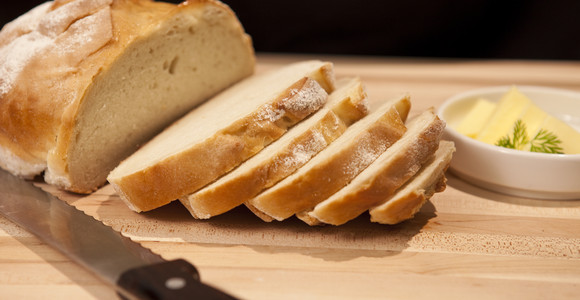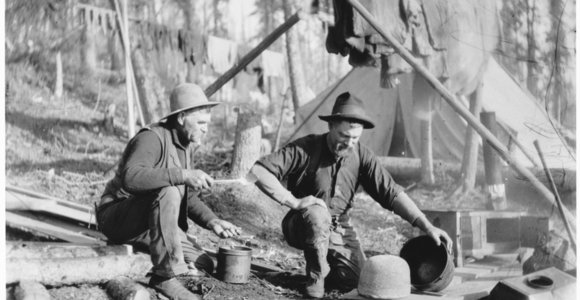Parks Canada Heritage Gourmet Recipes
Dawson City Sourdough Starter and Sourdough Bread
This process takes all day, but the smells that will fill your house while the bread is rising and baking will make it all worthwhile. You’ll probably find that at suppertime you’ll sit yourself down with a loaf of hot, fresh bread and a pound of butter and wonder how you ever got by without sourdough bread!

Origin: Dawson Historical Complex National Historic Site
Region: North (Yukon)
Period: 20th Century - present
Course: Breads and Pancakes
 Sandy’s First Loaf
Sandy’s First Loaf © National Archives of Canada / H.J. Woodside Collection, PA-16141
The Dawson City Historical Complex commemorates the history of the Klondike, including the Gold Rush and the years that followed. Sourdough was an integral part of the harsh life of a miner during the Gold Rush. Sourdough starter was always available, either by borrowing some from a fellow miner or by starting one's own. Food was scarce in the Yukon and winters were long and lonely, so having some sourdough starter and a large bag of flour could greatly increase a miner’s quality of life.
Up in the Klondike today there are people who still share sourdough starter which originally came over the Chilkoot Trail. It’s a great living tradition to keep alive, so share and share alike – pioneer style!
Dawson City Sourdough Starter and Sourdough Bread
Ingredients:
-
Starter
- Flour
- Blood-warm water (water at about body temperature; like a bottle for a baby)
-
Bread
- 4 cups | 900 g flour
- ¼ cup sugar | 100 g
- 1 tsp | 5 g salt
- 2 cups | 500 ml Dawson City sourdough starter
- 1 egg (optional)
- 3-4 tsp | 15-20 ml oil or melted lard
- 2-2½ cups | 500-625 ml blood-warm water
- an additional 4 cups | 400 g flour
Directions:
-
Starter
- Mix equal amounts flour and blood-warm water in a container larger enough for the mixture to double. The container should be glass or crockery. Do not screw the lid on tight; the gases will need to escape. (A plastic container could also be used, just don’t fit the lid on tight.)
- Place the container in a warm spot for 2 or 3 days, until it has started to bubble and become smooth. Yes, you’re basically waiting for it to go bad! A layer of alcohol - yes, alcohol - will develop on top; stir this down before using. The more potent your sourdough, the more alcohol you’ll get, so be proud: you are making yeast, and it will smell like it! If it grows green mould, you can scoop it out or stir it in, it won’t hurt you. However, if it turns orange, throw it away and start over.
- Replenish your starter each time you use it, or once a week. Remember: it is a living thing! You have to feed it regularly. If you don’t use it, take out one cupful and replace with ½ cup of flour and ½ cup of water.
- Keep the starter on a warm shelf. If you are not going to use it, store it in the fridge, but remove it a day before you want to use it so it will become active again. When you use your sourdough, replace what you took out with ½ cup of blood-warm water and ½ cup of flour.
-
Bread
- In a large bowl, combine the flour, sugar and salt. Make a well in the centre, and add the sourdough starter, egg, oil and warm water. Stir together and add more water or flour as necessary to form a pancake batter-like consistency. Cover with greased waxed paper and a towel and set in a warm place to rise.
- When doubled and all bubbly, mix in enough flour (about 4 cups) to enable it to be kneaded into a smooth elastic ball. Let this rise again until doubled, about 4 hours, and then punch down and shape into loaves. Let this rise again until doubled and then bake in a 400°F (200°C) oven for about 10 minutes and then turn the oven down to 300°F (150°C) and let bake 30-40 minutes longer until the loaves sound hollow when you knock on them. Brush the loaves with butter.
Credits:
Recipe tested by Chef David Fairbanks, Algonquin College School of Hospitality and Tourism
This traditional recipe was submitted by Parks Canada staff at Dawson Historical Complex National Historic Site.
Related links
- Date modified :